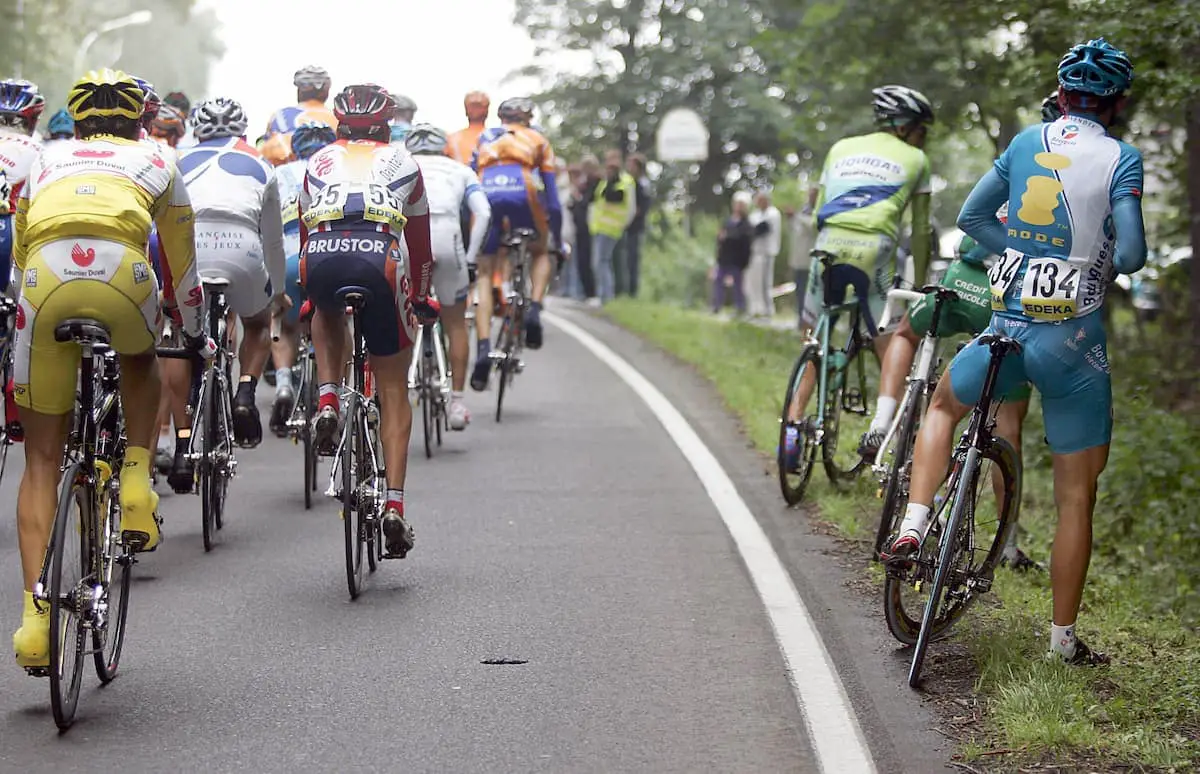If you spend 6+ hours in the saddle, you’re bound to need to pee at least a couple of times. Sometimes, nature calls at a bad time, and you can’t stop. That’s when cyclists pee right off the bike.
In the first part of the race, when the pace is not so fast, the riders usually stop on the side of the road to relieve themselves and then rejoin the peloton. When the pace picks up and stopping is no longer an option, they pee on the bike, usually helped by a teammate pushing them along.
For male cyclists, peeing on the bike during a race is much easier than for girls. Nature has provided them with a handy ‘tool’, while girls have to resort to a special technique.
Two ways to pee during a bike race
Nobody wants to pee when on a bike, but sometimes you just have to go. Spending several hours riding means you will have to pee at least once, and you can only hope you don’t get the urge to pee at a bad time.
During intense exercise, we pee less despite increased fluid intake. Most of it is excreted in sweat, but exercise also reduces kidney function, lowering urine production.
However, over several hours of riding, some urine does accumulate. At that point, the cyclist is forced to decide how to eliminate it – the ‘Classic’ way or the ‘Professional’ way.
The ‘Classic’ way

If riders could choose, they would always choose the classic way of urinating. This means they stop at the side of the road, pull out their ‘tool’ and do what they need to do.
It is the most natural form of urination for men, but it has a major drawback. It is quite time-consuming and leaves the rider far behind the group. That’s why it’s only used in the first part of the race when the pace is still low, and catching up is not a problem.
These pee stops are usually done in groups. Usually, when the race leader stops, so do the others. It is an unwritten rule that the leader is not attacked at such moments, which also reassures the others that they can do their business in peace.
Cyclists must pee in places where there are no spectators, otherwise they may be fined for public display.
Having more people working together makes catching the main group back easier. The peloton also has no interest in getting away, as there is a good chance that one of their teammates is among the cyclists who have stopped.
The riders return to the group with the help of cars. Riding in the lee allows them to maintain a high speed without wasting energy. Although it is not allowed to ride in the lee of a car for too long, the commissioners usually take it easy in this case.
The ‘Professional’ way

If they could, cyclists would always pee the ‘Classic’ way. But they can’t. Races are unpredictable, and riders don’t always have 30 seconds to pee in comfort. That’s when the ‘Professional’ way of peeing comes in.
The ‘Professional’ way of peeing means that you pee on the bike while riding. No, it does not mean the rider pees on himself, although we have seen such examples. And since peeing is more or less just water due to the amount of fluid drunk, it’s also less gross than it first sounds.
The riders move away from the group to the side of the road. They take their ‘tool’ out and swing their knee out on the side where they will pee. That gives them enough space to pee without peeing all over themselves.
Then a new problem arises. They might pee on the bike, but pedaling is impossible, meaning that riders begin to move slower than the group over time and start to slip behind.
And that’s why teammates exist.
Usually, when one of the team members pees, it affects two riders. The teammate rides alongside – on the other side of the pee, of course – and pushes the other rider from behind with one hand to ensure that he maintains a higher speed during peeing and doesn’t lose as much time.
Don’t be surprised if you’re wet
You probably heard the phrase: ‘Piss in the wind.’ Cyclists literally do it at every race.
The fact is that if you’re peeing while moving, expect to be wet. Some of the pee will land on you, but cyclists accept that. They also don’t mind too much, as peeing is more or less just water due to the high fluid intake.
Cycling is not the most hygienic sport.
If some pee lands on the rider, he takes a water bottle and splashes himself. This washes the pee droplets off and cools him down a bit. In the hot summer months, this is not a problem, but it is a bit harder to do when it is cold. But then again, the cold reduces urine production, so the urge to pee is reduced.
Because of the possibility of splashing pee, cyclists take a natural break at the side of the road. Even if they are peeing off their bike, they move to the side of the road to ensure that other riders do not get unpleasant ‘rain.’
Be prepared for a fine
Cyclists cannot pee wherever they like. There are rules about where they can and cannot do it. If they don’t respect them, there is a fine.
The main rule is to take a natural stop in places without any spectators. Public display is not allowed and is usually the main reason cyclists are fined.
However, sometimes it’s hard to find a place without spectators, or some spectators might surprise a cyclist who just started peeing. That’s why fines are not that severe, usually between 200 and 500 Swiss Francs ($230-$570).
Fines are paid from the team budget, which is funded by prize money from the race prize fund. These are usually much bigger than the penalties, so the riders don’t lose any sleep over fines.
Conclusion
Cyclists who spend several hours on a bike need to pee from time to time. In most cases, they stop on the side of the road and answer nature’s call. It’s actually quite common for a larger group to stop together and take a natural break.
However, sometimes stopping is not an option. That’s why professional cyclists learned to pee on the bike. They move to the side of the road, take out their ‘tool’ and do what they need to do.
Because they don’t want to lose too much speed and therefore time, they tend to do this in sections where the road is slightly downhill. But even more often, they are helped by their teammates, who push them from behind to make sure they remain part of the main group.
Peeing off a bike is not the most hygienic thing to do, and usually, a few drops of urine end up on the rider. The rider then rinses off with water from a bidon and continues the race without any problems.
If a cyclist is not careful in choosing where to pee, he may be fined. It is forbidden to pee in areas where there are spectators. Sometimes, this happens anyway, and the team pays the fine from the money collected from the prize fund.

